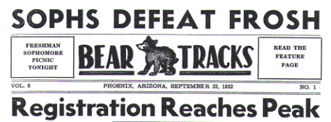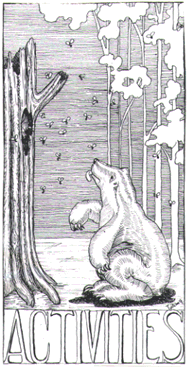
B.T. Evolves Since 1925
Bear Tracks May 4, 1979
Phoenix College's student newspaper, Bear Tracks, has a continuous history reaching back nearly 54 years. It first started in the fall of 1925 as a booklet-sized, four-page periodical. At this time, it was not called Bear Tracks, but Bear Growls. The school yearbook, the first issue of which appeared in the spring of 1926, was called Bear Tracks instead.
The story of how Bear Track's got it's name is an amusing one. Early in the school year 1925-26, a contest was held to name the yearbook, which was then beginning production on its first issue. A staff member of Bear Growls, Bertram Morse, suggested the name "Bear Facts."
This name was submitted handwritten in ink to Neil C. Cook, the advisor on both the newspaper and yearbook. Cook misread the entry as being "Bear Tracks," and this name was later voted in as the name of the yearbook.
In the spring of 1931, the newspaper and the yearbook were combined into a sectional annual, or monthly magazine, under the name of Bear Tracks. All of the issues of this magazine were bound together at the end of the school year for distribution to the students as a yearbook. Bound into the book also were photographs of, among other things, the campus clubs and graduating students.
 This arrangement lasted for only two years, until the fall of 1932, when the publication became a weekly newspaper -- Bear Tracks. The yearbook, in effect, no longer existed, although all issues, including some special issues with group photos, were still bound together at the end of the year for students.
This arrangement lasted for only two years, until the fall of 1932, when the publication became a weekly newspaper -- Bear Tracks. The yearbook, in effect, no longer existed, although all issues, including some special issues with group photos, were still bound together at the end of the year for students.
In 1933-34, a fourteen page, annual-like section was included with the bound issues of Bear Tracks. Over the next several years, this section grew to be relatively large. In 1948-49, it was published as a separate booklet at the end of the year, and later went on to become a true annual again, Sandprints.
Since the newspaper's beginning in 1925, its basic format and policies have changed considerably. Prior to the early 1940's, the paper seemed to be primarily interested in humor, jokes, fraternity and sorority activities, and similar matters.
With the onslaught of World War II, Bear Tracks began to be more like real journalism and less like a forum for jokes. Many articles and editorials began to appear that were far more grave in nature than before.
During the war years, hardly an issue came out that did not have something about the war in it. There were articles on the pros and cons of getting married during war time, on whether or not it was unpatriotic for a man to be in college at such a time instead of fighting in the armed services, and on former students who had recently been killed in battle.
After World War II, though Bear Tracks returned for the most part to be a spirit of levity, it no longer printed large volumes of humor for humor's sake. In addition, editorials still appeared not infrequently that dealt with serious social and political matters, not directly related to the campus.
Also about the time of World War II, photographs came into wide use in Bear Tracks. Before 1938-39, they had been seldom used in regular issues. However, in 1938-39 and 1939-40, photos often made up over one-half the content of the paper.
During the following three years, photographs again made only rare appearances. But in 1943-44, they began to be used in generally moderate numbers, similar to the present. They have remained in common use since.
Over the years, Bear Tracks has had several advisors. Included among the more notable of these were Neil C. Cook, the paper's first advisor; and Donald G. Hackett, advisor from spring 1953- Spring 1961, who is now a sociology instructor at PC. Also notable was Ramond T. Gallagher, Bear Tracks' advisor from fall 1968- Spring 1978.
After the end of the spring semester of 1978, Bear Tracks ceased being a production strictly of the journalism department, as it traditionally had been. In fall 1978, it was reorganized as a non-credit, student-operated activity.
Though there is still a faculty advisor, he generally keeps a low profile concerning how the paper is run. The present advisor, Mario Esquer, Coordinator of Student Activities, may make requests for certain types of stories, but usually only takes care of requisitions, draws up the budget, and performs other related tasks for the paper. He also solves any problems which arise that the student staff cannot handle.
Working on the student staff in past years have been a few people who later became part of the faculty at PC. One of these was Alexander Frazier, editor of Bear Growls in the school year 1929-30, who returned in 1941-42 to be the faculty advisor to the paper for that year and the first part of the following semester.
There was also Slibe Abounader, now a physical education instuctor, who was the paper's sports editor in school year 1941-42. Abounader also had his own column in that year and in the semester before. The column was first called "Bear with Slibe."
A person of note who once served on the newspaper's student staff, but did not return as an instructor, was John R. Williams, better known as Jack Williams. Williams went on to become the governor of Arizona nearly four decades after being the business manager for Bear Growls in the fall of 1928.
After almost 54 years, the future of Bear Tracks seems to be relatively secure. But since Bear Tracks is no longer a part of the journalism class anymore, it may be more difficult than in the past to acquire a staff for it. No editor as yet has been hired for the coming school year, but adviser Esquer seems confidant that one will be.
As it now stands, it is planned that Bear Tracks will be back next year, despite some uncertainty as to where the staff will come from and who will train them once they are found.
Part of the Phoenix College website.
Rendered on 8/12/98.